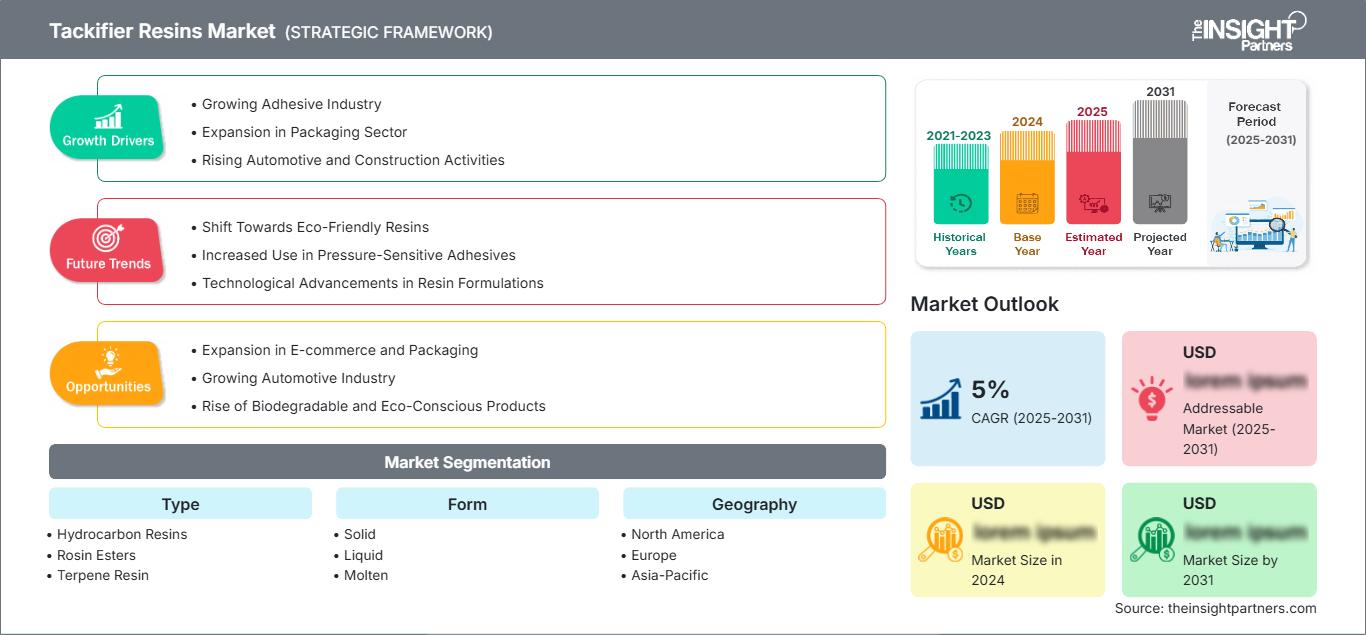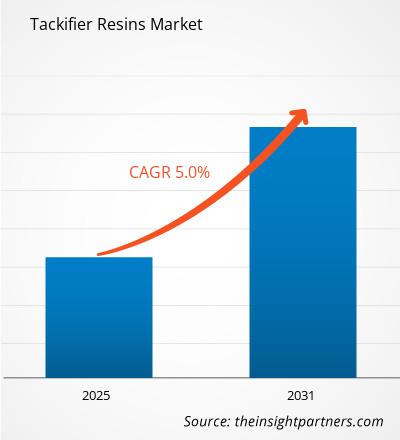Le marché des résines poisseuses devrait enregistrer un TCAC de 5 % entre 2025 et 2031, avec une taille de marché passant de XX millions de dollars américains en 2024 à XX millions de dollars américains d'ici 2031.
Le rapport présente une analyse par type (résines d'hydrocarbures, esters de colophane et résines terpéniques). Le rapport est segmenté par forme (solide, liquide et fondu). Le rapport présente une analyse par application (adhésifs thermofusibles, adhésifs sensibles à la pression, etc.). Le rapport est segmenté par utilisation finale (emballage, caoutchouc, construction, automobile, peintures et revêtements, remontage, etc.). L'analyse mondiale est ensuite ventilée au niveau régional et par principaux pays. La taille et les prévisions du marché aux niveaux mondial, régional et national pour tous les segments de marché clés sont couvertes dans le cadre du rapport. Le rapport indique la valeur en USD pour l'analyse et les segments ci-dessus. Français Le rapport fournit des statistiques clés sur l'état du marché des principaux acteurs du marché et offre des tendances et des opportunités de marché.
Objectif du rapport
Le rapport sur le marché des résines collantes de The Insight Partners vise à décrire le paysage actuel et la croissance future, les principaux facteurs moteurs, les défis et les opportunités. Cela fournira des informations à diverses parties prenantes commerciales, telles que :
- Fournisseurs de technologies/Fabricants : Pour comprendre la dynamique évolutive du marché et connaître les opportunités de croissance potentielles, leur permettant de prendre des décisions stratégiques éclairées.
- Investisseurs : Pour mener une analyse complète des tendances concernant le taux de croissance du marché, les projections financières du marché et les opportunités qui existent tout au long de la chaîne de valeur.
- Organismes de réglementation : Pour réglementer les politiques et les activités de police sur le marché afin de minimiser les abus, de préserver la confiance des investisseurs et de maintenir l'intégrité et la stabilité du marché.
Type de segmentation du marché des résines adhésives
- Résines hydrocarbonées
- Esters de colophane
- Résine terpénique
Forme
- Solide
- Liquide
- Fondu
Vous bénéficierez d’une personnalisation sur n’importe quel rapport - gratuitement - y compris des parties de ce rapport, ou une analyse au niveau du pays, un pack de données Excel, ainsi que de profiter d’offres exceptionnelles et de réductions pour les start-ups et les universités
Marché des résines collantes: Perspectives stratégiques

-
Obtenez les principales tendances clés du marché de ce rapport.Cet échantillon GRATUIT comprendra une analyse de données, allant des tendances du marché aux estimations et prévisions.
Moteurs de croissance du marché des résines poisseuses
- Industrie adhésive en pleine croissance : La demande croissante d’adhésifs dans diverses applications, telles que l’emballage, l’automobile et la construction, stimule le marché des résines poisseuses. Les poisseuses améliorent la force de liaison et les performances des adhésifs, favorisant leur utilisation dans les formulations adhésives haute performance et stimulant la croissance du marché dans de nombreux secteurs.
- Expansion dans le secteur de l’emballage : Avec la croissance de l’industrie mondiale de l’emballage, en particulier dans les secteurs de l’alimentation et des biens de consommation, le besoin de solutions adhésives efficaces augmente. Les résines poisseuses améliorent les performances des adhésifs sensibles à la pression utilisés dans les étiquettes, les rubans adhésifs et les matériaux d’emballage, stimulant la demande dans ce secteur à mesure que les exigences en matière d’emballage deviennent plus complexes.
- Activités croissantes dans l’automobile et la construction : Les secteurs de l’automobile et de la construction sont des moteurs importants du marché des résines poisseuses. Ces résines sont essentielles dans les produits d’étanchéité, les adhésifs automobiles et les matériaux de construction, car elles améliorent les propriétés de liaison et la durabilité. L'expansion des infrastructures et de la production automobile alimente la demande pour ces résines dans les deux secteurs.
Tendances futures du marché des résines poisseuses
- Évolution vers des résines écologiques : La demande de produits durables et écologiques favorise l'adoption de résines poisseuses biosourcées et recyclables. Alors que les industries se concentrent sur la réduction de leur empreinte environnementale, les fabricants développent des alternatives végétales et à faible teneur en COV, répondant ainsi aux préférences croissantes des consommateurs et des autorités réglementaires pour des solutions plus écologiques.
- Utilisation accrue des adhésifs sensibles à la pression : Les adhésifs sensibles à la pression (PSA) sont largement utilisés dans des secteurs tels que l'emballage, l'automobile et la santé. Les résines poisseuses, qui améliorent les performances des PSA, connaissent une demande croissante, car les industries recherchent des solutions de collage durables et efficaces offrant une adhérence supérieure sans chaleur ni solvants.
- Progrès technologiques dans les formulations de résines : L'innovation continue dans la technologie des résines conduit au développement de résines poisseuses avancées aux propriétés améliorées. Ces résines sont adaptées à des applications spécifiques, telles que la résistance aux hautes températures ou la stabilité aux UV, améliorant leurs performances et élargissant leur utilisation dans des secteurs comme l'automobile, l'électronique et la construction.
Opportunités de marché des résines tackifiantes
- Expansion du commerce électronique et de l'emballage : à mesure que le commerce électronique continue de croître, la demande de solutions d'emballage efficaces augmente, ce qui entraîne le besoin d'adhésifs haute performance. Les résines tackifiantes sont essentielles à la création de matériaux d'emballage solides et fiables, offrant une opportunité de croissance significative alors que les entreprises se concentrent sur des solutions d'emballage durables et rentables.
- Industrie automobile en pleine croissance : l'utilisation croissante d'adhésifs dans la fabrication automobile présente une forte opportunité pour les résines tackifiantes. Ces résines sont essentielles pour améliorer la force de liaison des composants automobiles tels que les panneaux intérieurs, les capteurs et l'isolation, et offrent une croissance significative du marché à mesure que le secteur automobile intègre davantage de technologies adhésives.
- Essor des produits biodégradables et éco-responsables : Le marché des résines poisseuses dérivées de sources renouvelables et biosourcées offre un potentiel croissant. La durabilité devenant de plus en plus importante, les fabricants peuvent capitaliser sur cette tendance en proposant des alternatives écologiques qui répondent à la demande des consommateurs pour des produits éco-responsables dans des secteurs tels que l'emballage et les adhésifs.
Marché des résines adhésives
Les tendances régionales et les facteurs influençant le marché des résines adhésives tout au long de la période de prévision ont été analysés en détail par les analystes de The Insight Partners. Cette section aborde également les segments et la répartition géographique du marché des résines adhésives en Amérique du Nord, en Europe, en Asie-Pacifique, au Moyen-Orient et en Afrique, ainsi qu'en Amérique du Sud et en Amérique centrale.Portée du rapport sur le marché des résines adhésives| Attribut de rapport | Détails |
|---|---|
| Taille du marché en 2024 | US$ XX million |
| Taille du marché par 2031 | US$ XX Million |
| TCAC mondial (2025 - 2031) | 5% |
| Données historiques | 2021-2023 |
| Période de prévision | 2025-2031 |
| Segments couverts |
By Type
|
| Régions et pays couverts |
Amérique du Nord
|
| Leaders du marché et profils d'entreprises clés |
|
Densité des acteurs du marché des résines adhésives : comprendre son impact sur la dynamique commerciale
Le marché des résines poisseuses connaît une croissance rapide, portée par une demande croissante des utilisateurs finaux, due à des facteurs tels que l'évolution des préférences des consommateurs, les avancées technologiques et une meilleure connaissance des avantages du produit. Face à cette demande croissante, les entreprises élargissent leur offre, innovent pour répondre aux besoins des consommateurs et capitalisent sur les nouvelles tendances, ce qui alimente la croissance du marché.
- Obtenez le Marché des résines collantes Aperçu des principaux acteurs clés
Principaux arguments de vente
- Couverture exhaustive : Le rapport couvre l’analyse exhaustive des produits, services, types et utilisateurs finaux du marché des résines adhésives, offrant un panorama global.
- Analyse d’experts : Le rapport est élaboré à partir d’une compréhension approfondie des experts et analystes du secteur.
- Informations actualisées : Le rapport garantit la pertinence commerciale grâce à sa couverture des informations récentes et des tendances des données.
- Options de personnalisation : Ce rapport peut être personnalisé pour répondre aux besoins spécifiques des clients et s’adapter aux stratégies commerciales.
Le rapport de recherche sur le marché des résines adhésives peut donc contribuer à la compréhension du marché et des perspectives de croissance. Malgré quelques préoccupations légitimes, les avantages globaux de ce rapport tendent à l’emporter sur les inconvénients.
- Analyse historique (2 ans), année de base, prévision (7 ans) avec TCAC
- Analyse PEST et SWOT
- Taille du marché Valeur / Volume - Mondial, Régional, Pays
- Industrie et paysage concurrentiel
- Ensemble de données Excel
Rapports récents
Rapports connexes
Témoignages
Raison d'acheter
- Prise de décision éclairée
- Compréhension de la dynamique du marché
- Analyse concurrentielle
- Connaissances clients
- Prévisions de marché
- Atténuation des risques
- Planification stratégique
- Justification des investissements
- Identification des marchés émergents
- Amélioration des stratégies marketing
- Amélioration de l'efficacité opérationnelle
- Alignement sur les tendances réglementaires






















 Obtenez un échantillon gratuit pour - Marché des résines collantes
Obtenez un échantillon gratuit pour - Marché des résines collantes